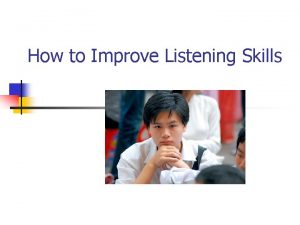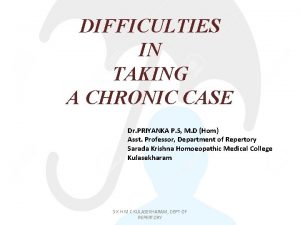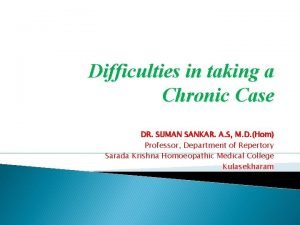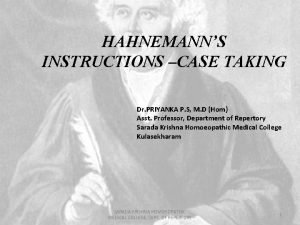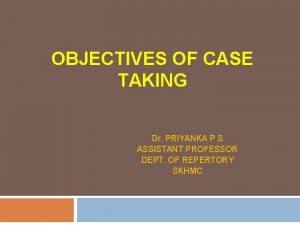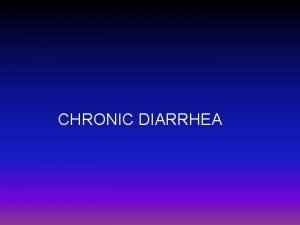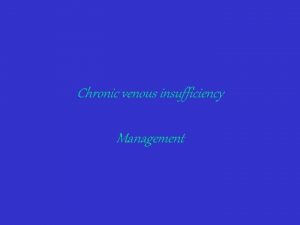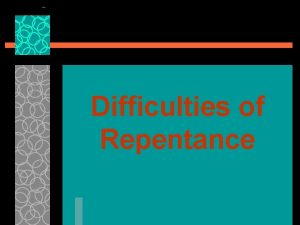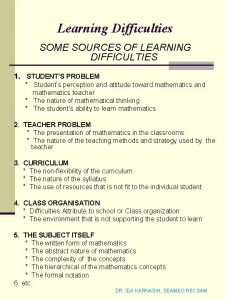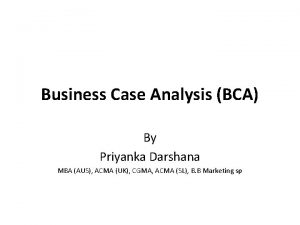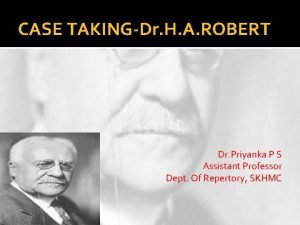DIFFICULTIES IN CHRONIC CASE TAKING DR PRIYANKA P



















- Slides: 19

DIFFICULTIES IN CHRONIC CASE TAKING DR. PRIYANKA P S ASSISTANT PROFESSOR DEPT. OF REPERTORY SKHMC, KULASEKHARAM.

WHAT IS A CASE? �A case is not merely a maze of symptoms, but an instance of disease, an event, and a change in the whole person from his original state of health to his present state of sickness. It is a totality of the alterations. It comprises of all the expressions on mental, physical plane and as part (s), which logically form a portrait of disease.

CASE TAKING �Case taking is a unique art of getting into conversation, observation and collecting information from patient as well as from bystanders to define the patient as a person and diagnose the disease.

OBJECTIVES OF CASE TAKING 1. To understand the patient in his surroundings- family, work and society 2. To define the problem of the person 3. To understand the disease of the individual with its common symptoms and characteristic symptoms 4. To attempt problem resolution and effective counselling, if needed. 5. To manage the case- auxillary, general and specific

OBJECTIVES OF CASE TAKING… Contd… 6. To help patient realize his problem so that he would cooperate in programming the treatment. 7. To help patient ventilate his problem so that he is relieved of carrying an emotional load. This has a great therapeutic value. 8. To find out the constitutional, intercurrent and acute totalities so that the respective remedies could be selected.

WHAT IS A CHRONIC DISEASE? �APHORISM: 72 � They are diseases of such a character that, with small, often imperceptible beginnings, dynamically derange the living organism, each in its own peculiar manner, and cause it gradually to deviate from the healthy condition, in such a way that the automatic life energy, called vital force, whose office is to preserve the health, only opposes to them at the commencement and during their progress imperfect, unsuitable, useless resistance, but is unable of itself to extinguish them, but must helplessly suffer (them to spread and) itself to be ever more and more abnormally deranged, until at length of the organism is destroyed : these are termed “Chronic Diseases”

WHAT IS A CHRONIC CASE? � A Chronic case is defined as a case which has a long history of its existence with a miasmatic background. �It shows slow and gradual change in its functioning and finally loses its capacity to function efficiently.

DIFFICULTIES IN CHRONIC CASE TAKING

1. GRADUAL IN ONSET � As chronic disease is gradual in onset, it is difficult to ascertain the accurate time of its beginning.

2. SLOW IN PROGRESS � Since progress is slow, unnoticeable, uneventful, patient cannot recall the initial symptoms in details. �So a few striking changes in the health are mentioned and all the components of initial symptoms will be difficult to record for a physician.

3. PARTIAL PICTURE OF DISEASE �The initial trivial symptoms of the disease will be neglected by the patient thinking that it is not much important to them and they remember only the grave changes. So there is a tendency to present only a partial picture of disease in chronic cases.

4. COMING LATE �Patient comes late after taking some kind of palliative treatment by themselves or might seek the help of some non- medical persons �Considerable time is wasted and the disease picture is greatly altered when he reports the Homoeopathic Physician. This makes the physician difficult to understand the whole phenomena of such cases.

5. PALLIATION, SUPPRESSION �Chronic cases comes to physician after a long palliative, suppressive treatment. So the whole picture and presentation of the disease is different. In such cases it is difficult to obtain an original unmodified picture which is important aspect in case taking.

6. LESSER ACCESSORY SYMPTOMS �Due to long standing suffering many of the symptoms become a part and parcel of the patients life. In such cases they give symptoms which is significant to him and doesnot gives any valuable symptoms.

7. EXPRESSIONS OF HEALTH �Due to lack of knowledge the patient may consider a few symptoms as expressions of health due to long standing presence. In such cases Concomitants (Related with time modality symptoms) and auxillary symptoms (Accompanying symptoms) are not narrated

8. ALTERNATING SYMPTOMS �Patient has alternating symptoms like joint complaints in summer & respiratory complaints in winter, they narrate only the presenting complaints & forgets to mention the other component. �This makes incomplete picture of disease.

9. SYMPTOMS OF MENTAL & PHYSICAL LEVEL �In chronic case all the deviations of physical & mental planes should be obtained to form portrait of disease. �Due to lack of understanding the patient doesnot share his /her symptoms in relation to emotion & intellect. Such cases construction of totality gets difficult & the case taking remains unfruitful.

10. PAEDIATRIC & GERIATRIC CASES �Cases of children, Persons with communication problem & Older age persons are difficult for case taking.

Queries if any ask ? ? Thank you
 Priyanka fish
Priyanka fish Priyanka n. rane
Priyanka n. rane Hypoventilation causes
Hypoventilation causes Financial risk protection
Financial risk protection Conjoint malady in repertory
Conjoint malady in repertory Priyanka gariba
Priyanka gariba Best case worst case average case
Best case worst case average case Financial difficulties are commonly caused by overspending
Financial difficulties are commonly caused by overspending Specific learning difficulties 中文
Specific learning difficulties 中文 Interactivity chart problem solving
Interactivity chart problem solving Listening skills
Listening skills Benefits and difficulties of improving quality
Benefits and difficulties of improving quality Foxmeyer erp failure case study
Foxmeyer erp failure case study Long case and short case
Long case and short case Bubble sort best case and worst case
Bubble sort best case and worst case Linear search big o notation
Linear search big o notation Bubble sort best case and worst case
Bubble sort best case and worst case Bubble sort algorithm pseudocode
Bubble sort algorithm pseudocode Case western reserve university case school of engineering
Case western reserve university case school of engineering Ambiguous case triangles
Ambiguous case triangles










